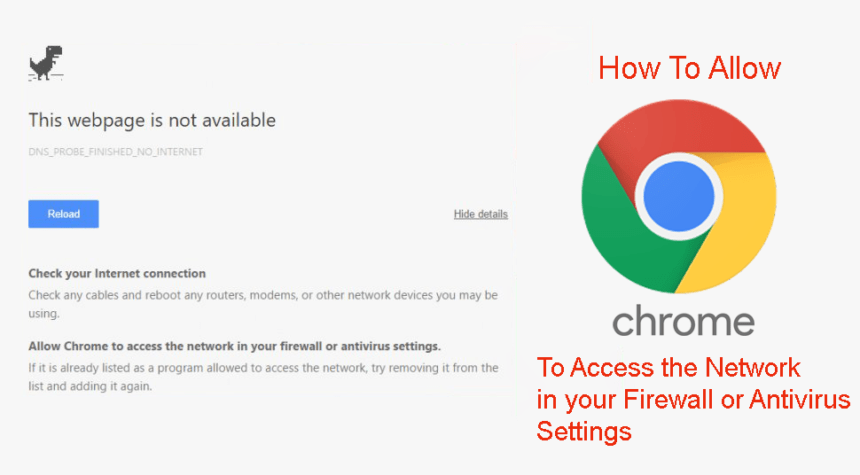The cause of the error “Allow Chrome to access the network in your firewall or antivirus settings” does not lie with the Chrome browser itself but with the firewall or the antivirus you are using.
- Method 1: Adding Chrome to the Windows Firewall Exception List
- Method 2: Adding Exclusion to Windows Virus and Threat Protection WIndows 10
- Adding Exclusion to Window Defender in Windows 7
- Method 3 (Antivirus): Allow Chrome to Access the Network in your Firewall or Antivirus Settings – Kaspersky
- Adding Chrome to the Exception List For Other OS and Antivirus Programs
- Allow Chrome to Access the Network in your Firewall or Antivirus Settings Chromebook
- Allow Chrome to Access the Network in your Firewall or Antivirus settings – Avast Free Antivirus
- How to Allow Chrome to Access the Network in your Firewall or Antivirus Settings Mac
- Allowing Chrome through Bitdefender
- Allowing Chrome through McAfee Antivirus
- Setting Exclusion for Chrome on Malwarebytes
A firewall or antivirus tracks the packets of data coming in and going out of your computer. It ensures no malicious codes enter your device that could potentially harm the computer; at times the firewall may make mistake and stop Chrome from accessing the network. In this blog, we will help you place Chrome in the list of programs allowed by your antivirus, Firewall, and Defender.
To resolve this problem we will help you add Chrome to the exception list of the antivirus and the firewall.
Method 1: Adding Chrome to the Windows Firewall Exception List
Windows Firewall is a built-in security application that was initially introduced with Windows XP and has continued ever since. It helps protect your computer from prying eyes or unauthorized users who might harm your computer. It monitors your internet or network activity, keeping an eye on the packets of data coming in and going out. It forms a protective wall between your computer and the internal and external network. The Firewall blocks several applications on your computer that has an untrusted digital signature or due to some other predetermined rule. It is common that the Firewall might block Chrome. Follow the below steps to include Chrome in the Firewall’s exception list:
- Press Windows + S to open the Windows Search Tab and Type Firewall
2. Open the Window Defender Firewall
3. Click on Allow an app or feature through Windows Defender Firewall

4. Before altering Click on Change settings and Check both Private and Public boxes and hit Ok.
If the problem persists, try turning the Windows Defender Firewall Off. This can be done by navigating back to the Defender Home Window and the option is at the right side below Allow an app or feature through Windows Defender Firewall.
Method 2: Adding Exclusion to Windows Virus and Threat Protection WIndows 10
- To add exclusion to Windows Defender please follow the below steps:
2. Press Windows Key + S to open the search tab. Type Windows Security and select the app.
3. On the Left Pane select Virus and Threat Protection
4. Under virus and threat protection settings, select Manage settings

5. Scroll down to locate Exclusions and click on Add or remove exclusions

6. Click on Add an exclusion and select Folder
7. Navigate to C drive > Program Files (x86), and find the folder named Google.

8. Select the folder and click Ok.
9. This would add Google Chrome to the Exclusion list of Windows Defender. To add other programs or to remove a program from the list, click on the file and select Remove.
That’s it! You are done. Now, try allowing Chrome through your Antivirus.
Here is video tutorial for the above two fixes.
Adding Exclusion to Window Defender in Windows 7
For users on Windows 7, you have the Windows Defender instead of Virus and Threat Protection. They are the same thing, only different names. Here are the steps to set an exception for Chrome on Windows Defender on Windows 7.
- Open Control Panel and click on Windows Defender
- Click on Tools with the gear icon
- Click on Options again with the gear icon
- From the left panel menu, click on Excluded files and folder
- Click on Add on the right side of the screen
- Browse, open, and select the Google Chrome .exe file (follow this path: C > Program Files (x86) > Google > Chrome > Application > Chrome.exe with the Chrome icon)
- Click Ok
This will add Chrome to the Windows Defender exclusion list on Window 7.
Method 3 (Antivirus): Allow Chrome to Access the Network in your Firewall or Antivirus Settings – Kaspersky
If you have an antivirus like Kaspersky installed, it will automatically disable the Windows Defender Firewall and the Defender Home will say “These settings are managed by vendor application Kaspersky Total Security”. Hence, Kaspersky is blocking Chrome from accessing the network. Follow the below steps to include Chrome in Kaspersky’s Trusted list.
- Open the Kaspersky and go to settings
2. Select Protection and click on Application Control
Note: The interface may differ depending on the version and variant of the Kaspersky protection you are using. Nonetheless, the steps remain the same.
3. Click on Manage Applications
4. A window will open that will display a list of applications; locate Google and under click on it and all the Google applications will be displayed.

5. Allow Chrome by toggling allow and this should do the trick.

Adding Chrome to the Exception List For Other OS and Antivirus Programs
Allow Chrome to Access the Network in your Firewall or Antivirus Settings Chromebook
The Chromebook has an inbuilt firewall, which helps you protect against external threats; however, sometimes it can create problems when it blocks Chrome from accessing the internet. Under such a circumstance, you need to program the firewall manually. Follow these steps to gain access to the firewall and reset its permissions.
- Log into the Chromebook
- Go to Menu
- Locate Administration Menu
- In the submenu, find Firewall
- If prompted, provide the root password
- Go to Allowed Services and grant Chrome access
- In the Firewall Configuration Summary, click Finish.
This would allow Chrome to bypass the firewall and access the internet.
Allow Chrome to Access the Network in your Firewall or Antivirus settings – Avast Free Antivirus
If a particular website is getting blocked on your computer or you are getting the error allow chrome to access the network in your firewall or antivirus settings when you try to use the browser, you need to put the website or Chrome in the exception list of Avast. The same concept we have discussed above.
- Open the Avast Antivirus and Click on menu on the top right corner.
- From the menu, go to Settings
- Select Exceptions and click on ADD EXCEPTION
- Type of the URL of the website in the field and click on the green button ADD EXCEPTION

- To allow Chrome access, click on Browse
- Go to Local Disk C
- Double-click on Programming Files (x86)
- Locate the Folder named Google

- Select the folder and Click Ok.
There you have it, this should work the magic and you should be able to access your website or the Chrome browser should have access to the internet.
If you want to remove the exception, simply click on the Delete sign next to the bin-box next to the exception items.
How to Allow Chrome to Access the Network in your Firewall or Antivirus Settings Mac
Putting Chrome in the exception list.
To allow a specific app to receive incoming connections, add it using Firewall Options:
- Open System Preferences
- Click Security or Security & Privacy icon
- Select the Firewall tab.
- Click lock icon in the preference pane, then enter an administrator name and password.
- Click the Firewall Options button
- Click the Add Application (+) button.
- Select the app you want to allow incoming connection privileges for.
- Click Add.
- Click OK.
You can also remove any apps listed here that you no longer want to allow by clicking the Remove App (-) button.
This should allow Chrome to access the internet on a Mac.
Allowing
Chrome through Bitdefender
Here are the steps to allow Chrome through the Bitdefender antivirus program.
- Open the Bitdefender application.
- Go to Protection from the menu on the left.
- From ADVANCED THREAT DEFENSE > Manage Exceptions > ADD AN EXCEPTION.
- Click on the magnify glass icon to browse and select the Google Chrome .exe file or simply drag and drop the Chrome .exe file in the search bar. (This PC > Local Disk (C:) > Program Files (x86) > Google > Chrome > Applications)
- Click ADD EXCEPTION to add exception to Chrome and close the window.
Allowing
Chrome through McAfee Antivirus
Follow the below steps to set an exception for Chrome on the McAfee Antivirus.
- Open the McAfee application and click on Firewall
- Click on Settings
- Expand the Program Permissions menu by clicking on the down arrow.
- Click on Add
- Set the Access to Full and click Browse button under Program.
- Go to This PC > Local Disk (C:) > Program Files (x86) > Google > Chrome and select the .exe file with the Chrome logo.
- Click on Save.
Setting
Exclusion for Chrome on Malwarebytes
Here are the steps you can follow to set the exclusion for the Chrome browser on Malwarebytes.
- Open the antivirus application.
- Go to Settings > Exclusions > Add Exclusion.
- Select Exclude a File or Folder and click Next.
- Click on Select Files and browse to the location (This PC > Local Disk (C:) > Program Files (x86) > Google > Chrome).
- Select the file Chrome.exe with the Chrome logo and click Open.
- Under How to Exclude, check the first option Exclude from detection as malware, ransomware or potentially unwanted item, and click OK.
Now the Chrome would be placed in the exclusion list of the antivirus and the error “Allow Chrome to Access the Network in your Firewall or Antivirus Settings” should disappear.
Read Next:








